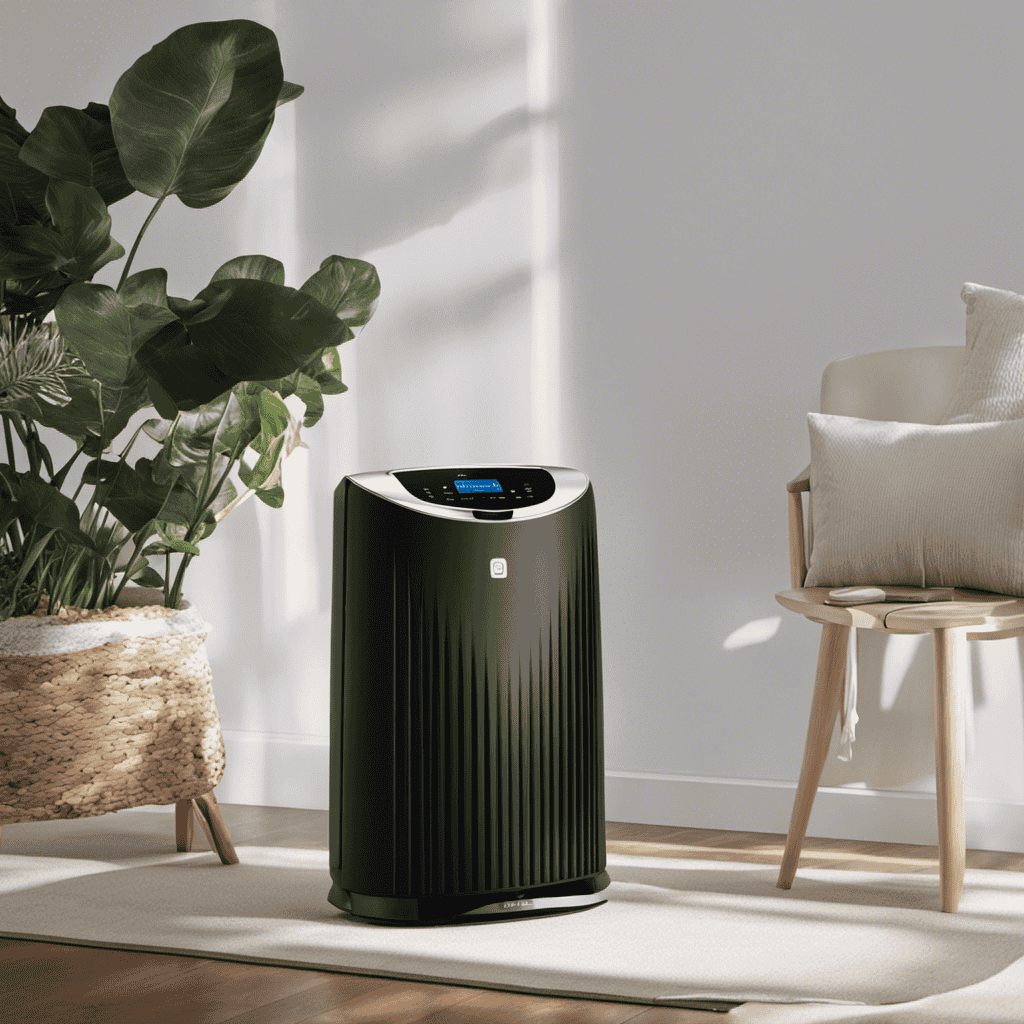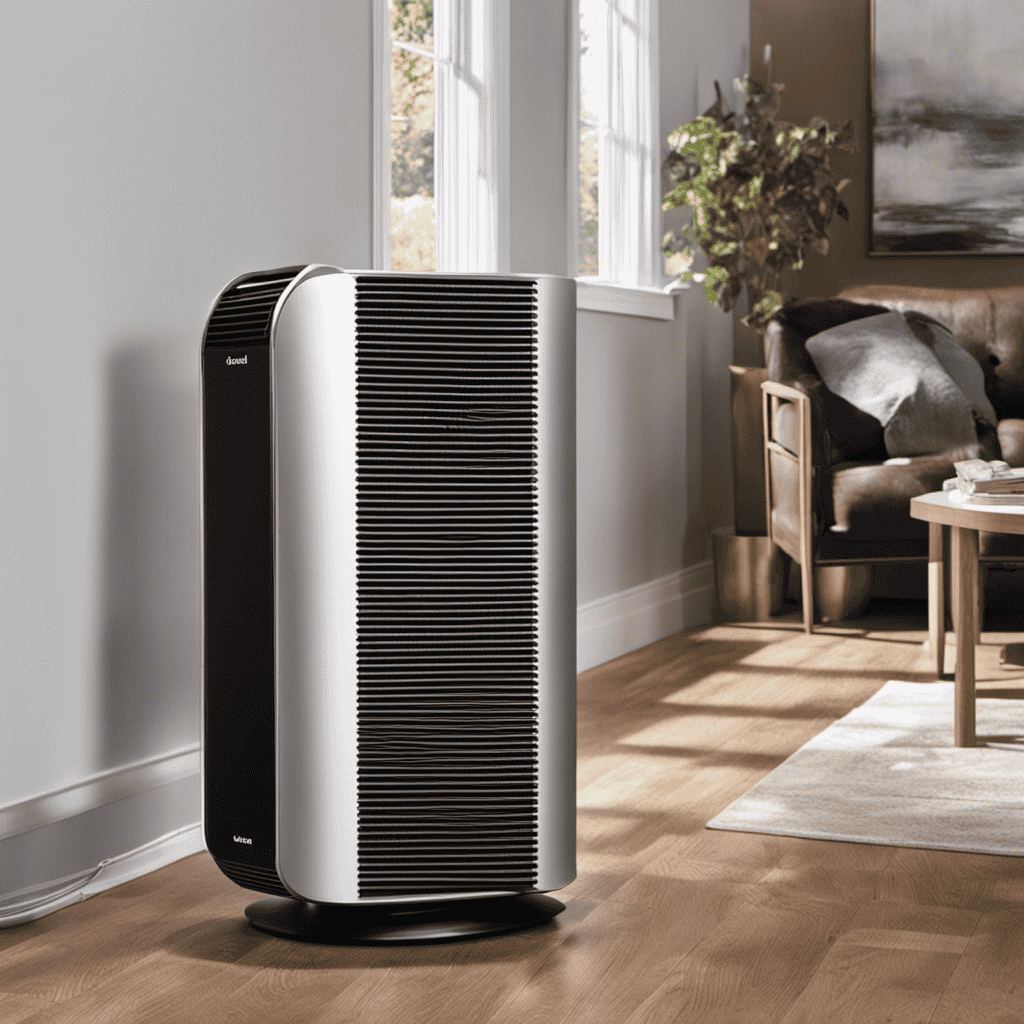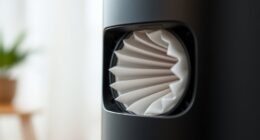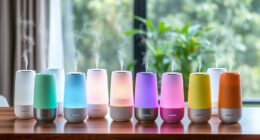So, you have a Live Pure Air Purifier, right? Well, I can assure you that keeping it clean will be very easy.
In this article, I’m gonna break it down for you step by step, no fluff, just the facts.
We’ll start by understanding the inner workings of the purifier and assessing its cleaning needs.
Then, armed with the necessary supplies, we’ll dive into the nitty-gritty of disinfecting and cleaning every nook and cranny.
Trust me, by the end of this, your Live Pure Air Purifier will be as good as new.
Let’s get started, shall we?
Key Takeaways
- The Live Pure Air Purifier has a multi-stage filtration system that removes airborne particles and eliminates odors.
- The HEPA filter traps 99.97% of particles as small as 0.3 microns.
- Proper maintenance techniques include cleaning the filters, wiping down the exterior, and cleaning the sensor if applicable.
- The frequency of cleaning should be based on environmental factors and usage, with filters cleaned every 3-6 months and the exterior cleaned monthly.
Understanding the Live Pure Air Purifier
To understand the Live Pure Air Purifier, you’ll need to read the user manual. This advanced device is designed to maintain air quality and provide numerous benefits for users.
The air purifier is equipped with a multi-stage filtration system that effectively removes airborne particles, such as dust, pollen, pet dander, and smoke. It also eliminates odors, capturing volatile organic compounds (VOCs) and other unpleasant smells. The HEPA filter within the purifier traps 99.97% of particles as small as 0.3 microns, ensuring cleaner and healthier air in your home or office.
In addition to improving air quality, the Live Pure Air Purifier offers several benefits. Firstly, it can help alleviate allergy symptoms by reducing the presence of allergens in the air. This is especially beneficial for individuals who suffer from seasonal allergies or asthma.
Secondly, the purifier can help eliminate unpleasant odors, creating a fresh and clean environment. This is particularly useful for homes with pets or smokers.
Lastly, the purifier can contribute to a better overall well-being by reducing exposure to harmful particles and improving the quality of the air you breathe.
Assessing the Cleaning Needs of Your Air Purifier
When it comes to maintaining your air purifier, there are several key points to consider.
First, it is important to understand the proper maintenance techniques for your specific model. This includes knowing how to clean the filters, remove and dispose of any trapped particles, and keep the unit running at optimal performance.
Additionally, understanding the frequency of cleaning is crucial to ensure that your air purifier continues to effectively remove pollutants from the air.
Finally, it is essential to be aware of common cleaning mistakes that can potentially damage the unit or reduce its efficiency.
Proper Maintenance Techniques
Regularly cleaning your air purifier is essential for its proper maintenance. To ensure optimal performance and longevity, here are some important cleaning tips.
- First, always refer to the manufacturer’s instructions for specific cleaning guidelines.
- Start by unplugging the purifier and removing the filters. Most filters can be rinsed with water, but some may require gentle cleaning with a soft brush. Be sure to let the filters dry completely before reinserting them.
- Next, wipe down the exterior of the purifier using a damp cloth and mild detergent, avoiding any electrical components. Pay extra attention to any vents or grilles where dust may accumulate.
- Lastly, remember to clean the sensor, if applicable, using a cotton swab and rubbing alcohol.
Following these maintenance techniques will help keep your air purifier running efficiently and effectively.
Frequency of Cleaning
You should consider how often you clean your air purifier to ensure it continues to function properly. Regular cleaning and maintenance are crucial for optimal performance and longevity of your Live Pure Air Purifier. The cleaning schedule will depend on various factors such as the environment, usage, and the manufacturer’s recommendations. It is generally recommended to clean the filters every 3-6 months, or as soon as you notice a decrease in air quality. Additionally, it is important to clean the exterior and internal components of the purifier regularly to remove dust, allergens, and other pollutants. When cleaning your air purifier, it is essential to use the recommended cleaning products provided by the manufacturer to avoid any damage or decrease in performance. Here is a table outlining a general cleaning schedule for your convenience:
| Component | Cleaning Frequency |
|---|---|
| Filters | Every 3-6 months |
| Exterior | Monthly |
| Internal Components | Every 6 months |
Common Cleaning Mistakes
Using the wrong cleaning products can potentially damage or reduce the effectiveness of your device. It’s important to avoid these common cleaning mistakes when it comes to cleaning your Live Pure Air Purifier.
-
Using harsh chemicals: Avoid using strong chemicals or solvents on your air purifier, as they can damage the internal components.
-
Neglecting the filters: Regularly cleaning and replacing the filters is crucial for maintaining the performance of your air purifier.
-
Cleaning the device while it’s on: Always turn off and unplug your air purifier before cleaning it to prevent any electrical accidents.
-
Ignoring the manufacturer’s instructions: It’s important to follow the specific cleaning instructions provided by the manufacturer to ensure effective cleaning and avoid any potential damage to your device.
To ensure the longevity and effectiveness of your Live Pure Air Purifier, follow these effective cleaning methods and avoid these common mistakes.
Gathering the Necessary Cleaning Supplies
To clean your Live Pure Air Purifier, start by gathering the necessary cleaning supplies. Having the right tools and products will ensure that you can effectively remove dirt, dust, and other pollutants from your air purifier. Here is a table listing the essential cleaning supplies you will need for the cleaning process:
| Cleaning Supplies | Purpose |
|---|---|
| Microfiber cloth | To wipe down the exterior surfaces of the air purifier |
| Mild detergent | To clean the filter and remove any buildup |
| Water | To mix with the detergent and rinse the filter |
| Soft-bristle brush | To gently scrub the filter and remove stubborn particles |
| Compressed air can | To blow away dust and debris from hard-to-reach areas |
Once you have gathered these supplies, you can proceed with the cleaning process. It is important to follow the manufacturer’s instructions for your specific air purifier model. Generally, you will need to unplug the unit and remove the filter. Use the soft-bristle brush to remove any large particles, then gently wash the filter with a mixture of mild detergent and water. Rinse the filter thoroughly and allow it to dry completely before reinserting it into the air purifier. Finally, use the microfiber cloth and compressed air can to clean the exterior and hard-to-reach areas of the purifier. With regular cleaning and maintenance, your Live Pure Air Purifier will continue to provide you with clean and fresh air.
Turning Off and Unplugging the Live Pure Air Purifier
To ensure a safe and effective cleaning process for your Live Pure Air Purifier, the first step is to turn off and unplug the device. This is crucial to prevent any electrical accidents and to protect both yourself and the purifier from any potential harm. Here’s how to do it:
- Locate the power supply cord at the back of the purifier.
- Gently pull the power supply cord from the electrical outlet.
- Check the purifier’s control panel to make sure it is completely turned off.
- Once confirmed, unplug the power cord from the back of the purifier.
By following these steps, you can ensure that the Live Pure Air Purifier is completely disconnected from the power source, reducing any risk of electric shock during the cleaning process.
Now that the purifier is safely disconnected, we can move on to the next step: removing and cleaning the air filter(s).
Removing and Cleaning the Air Filter(s
Now that you have safely disconnected the power source, it’s time to take out and clean the air filter(s). Cleaning the air filter(s) is an important step in maintaining the efficiency and performance of your Live Pure air purifier.
To begin, locate the air filter compartment on the unit. Depending on the model, this compartment may be on the back or side of the purifier. Once located, carefully open the compartment and remove the air filter(s).
To clean the air filter(s), you will need a mild cleaning solution. Mix a small amount of the cleaning solution with water in a bucket or sink. Gently submerge the air filter(s) in the solution and allow them to soak for about 15 minutes. This will help loosen any dirt, dust, or debris trapped in the filters. After soaking, use a soft brush or cloth to gently scrub the filters, removing any remaining dirt.
Once the filters are clean, rinse them thoroughly with clean water to remove any residue from the cleaning solution. After rinsing, gently squeeze out any excess water and allow the filters to air dry completely. It is important to ensure that the filters are completely dry before reinstalling them in the air purifier. This will prevent the growth of mold or mildew.
Now that the air filter(s) are clean and dry, they can be safely reinstalled into the air purifier. Make sure they are properly aligned and securely placed back in the compartment. Once the filters are in place, you can proceed to the next step of cleaning the exterior surfaces of the air purifier.
Cleaning the Exterior Surfaces of the Air Purifier
After the air filter(s) have been reinstalled, you can use a damp cloth to wipe down the exterior surfaces of the purifier. Cleaning the exterior surfaces of the air purifier is an essential step to maintain its performance and prolong its lifespan.
Here are some detailed instructions on how to effectively clean the exterior of your Live Pure Air Purifier:
-
Start by unplugging the purifier from the power source to ensure safety.
-
Use a damp cloth or sponge and gently wipe the exterior surfaces of the purifier. Make sure to remove any dirt, dust, or fingerprints that may have accumulated over time.
-
Pay special attention to the air vents, as they can easily become clogged with dust and debris. Use a soft brush or a cotton swab to carefully clean the air vents and remove any trapped particles.
-
For stubborn stains or marks, you can mix a mild detergent with water and apply it to the cloth. Gently scrub the affected areas until the stains are removed, being careful not to damage any sensitive parts of the purifier.
Cleaning the Fan and Ventilation System
Make sure you unplug the device before cleaning the fan and ventilation system to ensure your safety. Cleaning the motor components and removing dust buildup from the fan and ventilation system is an important maintenance task for your Live Pure Air Purifier. Neglecting this task can lead to reduced performance and potential damage to the motor.
To clean the fan and ventilation system, follow these steps:
- Turn off the air purifier and unplug it from the power source.
- Remove the front cover of the purifier to access the fan and ventilation system.
- Use a soft brush or a vacuum cleaner with a brush attachment to gently remove dust and debris from the fan blades and surrounding areas. Be careful not to damage the blades.
- Use a damp cloth to wipe down the fan and ventilation system, removing any remaining dirt or residue.
- Allow the components to dry completely before reassembling the air purifier.
Regularly cleaning the motor components and removing dust buildup will help maintain the performance and longevity of your Live Pure Air Purifier. Refer to the table below for a quick overview of the cleaning process:
| Step | Instructions |
|---|---|
| 1 | Turn off and unplug the air purifier. |
| 2 | Remove the front cover. |
| 3 | Brush or vacuum the fan blades and surrounding areas. |
| 4 | Wipe down the fan and ventilation system. |
| 5 | Allow components to dry before reassembling. |
Disinfecting the Live Pure Air Purifier
To keep your device sanitized, it’s important to regularly disinfect the various components of your Live Pure Air Purifier. Here are some effective disinfecting methods and cleaning products to ensure a clean and healthy environment for you and your family:
-
Use a mild soap and water solution to wipe down the exterior surfaces of the air purifier. Avoid using abrasive cleaners or harsh chemicals that could damage the device.
-
For the filter, remove it according to the manufacturer’s instructions and gently rinse it under running water. Allow it to air dry completely before reassembling it back into the purifier.
-
To disinfect the fan and ventilation system, use a disinfectant spray specifically designed for air purifiers. Follow the instructions on the product label and make sure to thoroughly spray the internal components.
-
Pay special attention to the air intake and outlet areas, as these are the main pathways for air circulation. Use a soft brush or a cotton swab to reach into any crevices and remove any accumulated dust or debris.
By regularly disinfecting your Live Pure Air Purifier using these methods and products, you can ensure that it continues to provide you with clean and fresh air.
Now, let’s move on to cleaning the control panel and buttons.
Cleaning the Control Panel and Buttons
When cleaning the control panel and buttons, be sure to use a soft cloth and a mild cleaning solution. The control panel is an essential component of your Live Pure Air Purifier, and keeping it clean is crucial for its proper functioning.
To clean the display panel, dampen the soft cloth with the mild cleaning solution and gently wipe the surface. Be careful not to let any liquid seep into the control panel as it can damage the internal components.
For the control buttons, use the same soft cloth and cleaning solution, ensuring that you wipe each button thoroughly. Pay extra attention to any crevices or hard-to-reach areas where dust and dirt may accumulate. Sanitizing the control buttons is essential to maintain a hygienic environment.
Once you have finished cleaning the control panel and buttons, allow them to air dry completely before reassembling and testing the air purifier. Ensuring the cleanliness of these components will not only enhance the appearance of your air purifier but also prolong its lifespan and maintain its optimal performance.
Reassembling and Testing the Air Purifier
Once you’ve finished reassembling the control panel and buttons, it’s time to test the air purifier to ensure it’s functioning properly.
Testing the air purifier is an important step to ensure that it is working efficiently and effectively. Here are some tips to help you with reassembling and testing your air purifier:
-
Check for any loose connections or damaged parts: Before testing the air purifier, make sure that all the connections are secure and there are no damaged parts. Loose connections can affect the performance of the air purifier.
-
Power on the air purifier: Once you have reassembled the control panel and buttons, plug in the air purifier and turn it on. The power button is usually located on the control panel.
-
Check the display: The air purifier should display the current settings and indicate that it is running. If there are any error messages or the display is not working properly, you may need to double-check the connections or consult the user manual for troubleshooting steps.
-
Test the air purifier’s functions: Test the different functions of the air purifier, such as the fan speed settings, timer, and filter replacement indicator. Make sure that each function is working as intended.
Maintenance Tips for Keeping Your Live Pure Air Purifier Clean
When it comes to maintaining the cleanliness of my Live Pure Air Purifier, two key factors come into play: cleaning frequency and the best cleaning techniques.
To ensure optimal performance and longevity of the purifier, it is important to clean it regularly. The cleaning frequency will depend on factors such as the air quality in your environment and the usage of the purifier.
Additionally, using the best cleaning techniques will ensure that all the filters and components are thoroughly cleaned, allowing the purifier to effectively remove pollutants from the air.
Cleaning Frequency for Purifier
To maintain optimal performance, you should regularly clean your Live Pure air purifier. Cleaning your air purifier at the appropriate intervals ensures that it continues to effectively remove pollutants from the air. Here is a recommended cleaning schedule for your Live Pure air purifier:
- Every month, clean the pre-filter by gently vacuuming or rinsing it under running water.
- Every three months, clean the carbon filter by gently vacuuming or rinsing it under running water, making sure to remove any accumulated debris.
- Every six months, clean the HEPA filter by vacuuming it or using a soft brush to remove dust and particles.
- Every year, deep clean the entire unit by wiping the exterior with a damp cloth and using a mild detergent to clean the filters.
When cleaning your Live Pure air purifier, always refer to the manufacturer’s instructions for specific cleaning products and techniques.
Best Cleaning Techniques
For optimal performance, it’s important to regularly maintain and clean your Live Pure air purifier using the recommended techniques.
When assessing cleaning techniques, start by unplugging the purifier and removing the front panel. Gently wipe the exterior with a soft, damp cloth to remove any dust or debris.
Next, remove the filters and assess their condition. If they are visibly dirty or discolored, it’s time to clean or replace them. To clean the filters, gently vacuum or rinse them under running water. Allow them to thoroughly dry before reinstalling.
Troubleshooting cleaning issues can be done by checking the airflow. If it’s weak, check for any clogs or obstructions in the filters or air vents.
Regularly following these cleaning techniques will ensure your Live Pure air purifier functions optimally and provides clean, fresh air.
Frequently Asked Questions
Can I Use Any Type of Cleaning Solution to Clean the Exterior Surfaces of the Live Pure Air Purifier?
I can use various cleaning solutions to clean the exterior surfaces of the Live Pure Air Purifier. However, it’s important to choose the right cleaning solution to avoid damaging the unit.
I recommend using mild soap and water or a non-abrasive household cleaner. Avoid using harsh chemicals or abrasive cleaning agents, as they can scratch or discolor the surfaces.
It’s also important to follow the proper cleaning techniques provided in the user manual for best results.
How Often Should I Clean the Fan and Ventilation System of the Live Pure Air Purifier?
When it comes to cleaning the fan and ventilation system of the Live Pure Air Purifier, it is important to follow the best cleaning practices. Regular maintenance is essential to ensure optimal performance and prolong the lifespan of the purifier.
Cleaning the fan and ventilation system should be done periodically to remove dust and debris that may accumulate over time. By doing so, you can maintain a clean and efficient air purifier that provides you with pure and fresh air.
Is It Safe to Use Disinfectant Wipes on the Control Panel and Buttons of the Live Pure Air Purifier?
Using disinfectant wipes on the control panel and buttons of the Live Pure Air Purifier can be safe, but there are pros and cons to consider.
While wipes can effectively remove dirt and germs, they may leave residue on the surface or damage the buttons if they are too wet.
An alternative cleaning method for the control panel and buttons is to use a soft cloth dampened with water and mild soap.
This will help maintain the integrity of the control panel and buttons.
Are There Any Specific Maintenance Tips for Keeping the Live Pure Air Purifier Clean and in Good Working Condition?
Cleaning tips and maintenance suggestions are important for keeping the Live Pure Air Purifier clean and in good working condition.
Regularly cleaning the exterior with a damp cloth and mild detergent helps to remove dust and dirt.
Cleaning or replacing the filters periodically is essential for optimal performance.
It is also recommended to check and clean the air vents to ensure proper airflow.
Following these maintenance tips will help extend the lifespan of the air purifier.
Can I Use a Vacuum Cleaner to Clean the Air Filter(S) of the Live Pure Air Purifier?
Sure, you can use a vacuum cleaner to clean the air filter(s) of the Live Pure Air Purifier. However, it is recommended to use compressed air instead.
Using compressed air ensures a more thorough cleaning, as it helps to remove the dust and debris that may be trapped in the filter.
Additionally, remember to clean the exterior surfaces of the air purifier using a damp cloth to remove any dirt or smudges.
Is the Cleaning Process the Same for Different Brands of Air Purifiers?
When it comes to cleaning Levoit air purifier tips, the process may vary from brand to brand. While some models may require regular filter replacements, others can be easily cleaned with a damp cloth or vacuum. It’s important to consult the user manual for specific cleaning instructions for different brands of air purifiers.
Conclusion
In conclusion, cleaning the Live Pure Air Purifier is like tending to a delicate garden.
Just as we carefully remove weeds and nourish the soil, we must take the time to assess, gather supplies, and clean every nook and cranny of the purifier.
Disinfecting and cleaning the control panel is like polishing the garden tools, ensuring they are in pristine condition.
By following these steps and maintaining regular cleaning, your Live Pure Air Purifier will continue to bloom with fresh, pure air, creating a healthy environment for you and your loved ones.










